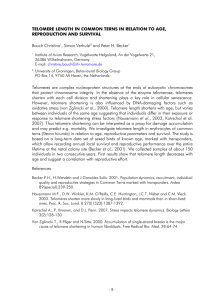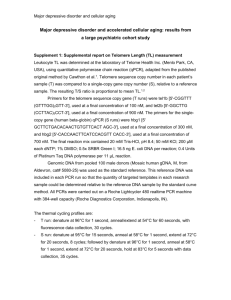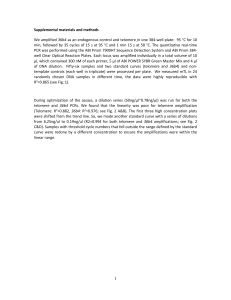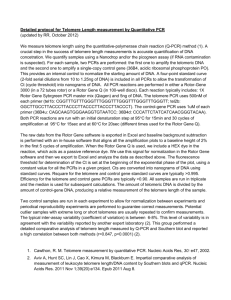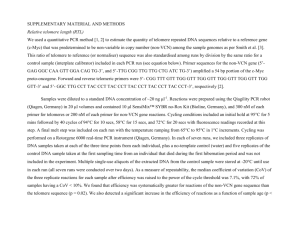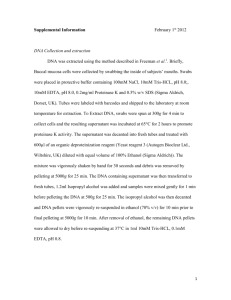Calibrating the telomere clock in common terns, Sterna hirundo
advertisement
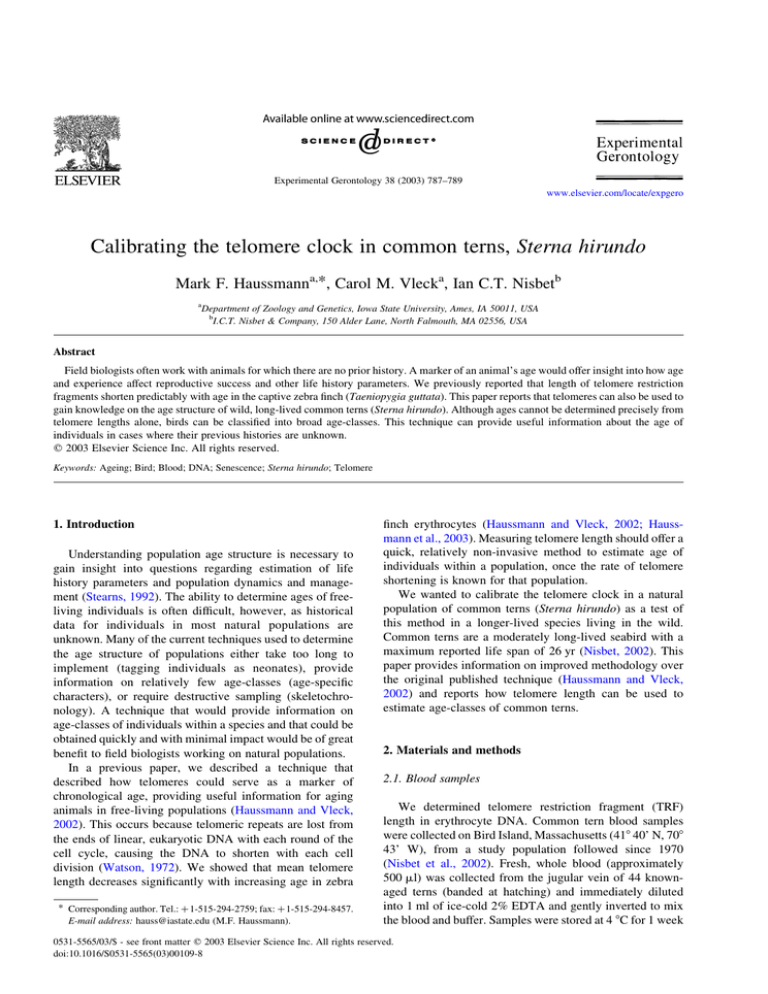
Experimental Gerontology 38 (2003) 787–789 www.elsevier.com/locate/expgero Calibrating the telomere clock in common terns, Sterna hirundo Mark F. Haussmanna,*, Carol M. Vlecka, Ian C.T. Nisbetb a Department of Zoology and Genetics, Iowa State University, Ames, IA 50011, USA b I.C.T. Nisbet & Company, 150 Alder Lane, North Falmouth, MA 02556, USA Abstract Field biologists often work with animals for which there are no prior history. A marker of an animal’s age would offer insight into how age and experience affect reproductive success and other life history parameters. We previously reported that length of telomere restriction fragments shorten predictably with age in the captive zebra finch (Taeniopygia guttata). This paper reports that telomeres can also be used to gain knowledge on the age structure of wild, long-lived common terns (Sterna hirundo). Although ages cannot be determined precisely from telomere lengths alone, birds can be classified into broad age-classes. This technique can provide useful information about the age of individuals in cases where their previous histories are unknown. q 2003 Elsevier Science Inc. All rights reserved. Keywords: Ageing; Bird; Blood; DNA; Senescence; Sterna hirundo; Telomere 1. Introduction Understanding population age structure is necessary to gain insight into questions regarding estimation of life history parameters and population dynamics and management (Stearns, 1992). The ability to determine ages of freeliving individuals is often difficult, however, as historical data for individuals in most natural populations are unknown. Many of the current techniques used to determine the age structure of populations either take too long to implement (tagging individuals as neonates), provide information on relatively few age-classes (age-specific characters), or require destructive sampling (skeletochronology). A technique that would provide information on age-classes of individuals within a species and that could be obtained quickly and with minimal impact would be of great benefit to field biologists working on natural populations. In a previous paper, we described a technique that described how telomeres could serve as a marker of chronological age, providing useful information for aging animals in free-living populations (Haussmann and Vleck, 2002). This occurs because telomeric repeats are lost from the ends of linear, eukaryotic DNA with each round of the cell cycle, causing the DNA to shorten with each cell division (Watson, 1972). We showed that mean telomere length decreases significantly with increasing age in zebra * Corresponding author. Tel.: þ 1-515-294-2759; fax: þ1-515-294-8457. E-mail address: hauss@iastate.edu (M.F. Haussmann). finch erythrocytes (Haussmann and Vleck, 2002; Haussmann et al., 2003). Measuring telomere length should offer a quick, relatively non-invasive method to estimate age of individuals within a population, once the rate of telomere shortening is known for that population. We wanted to calibrate the telomere clock in a natural population of common terns (Sterna hirundo) as a test of this method in a longer-lived species living in the wild. Common terns are a moderately long-lived seabird with a maximum reported life span of 26 yr (Nisbet, 2002). This paper provides information on improved methodology over the original published technique (Haussmann and Vleck, 2002) and reports how telomere length can be used to estimate age-classes of common terns. 2. Materials and methods 2.1. Blood samples We determined telomere restriction fragment (TRF) length in erythrocyte DNA. Common tern blood samples were collected on Bird Island, Massachusetts (418 40’ N, 708 43’ W), from a study population followed since 1970 (Nisbet et al., 2002). Fresh, whole blood (approximately 500 ml) was collected from the jugular vein of 44 knownaged terns (banded at hatching) and immediately diluted into 1 ml of ice-cold 2% EDTA and gently inverted to mix the blood and buffer. Samples were stored at 4 8C for 1 week 0531-5565/03/$ - see front matter q 2003 Elsevier Science Inc. All rights reserved. doi:10.1016/S0531-5565(03)00109-8 788 M.F. Haussmann et al. / Experimental Gerontology 38 (2003) 787–789 until they were returned to Iowa State University where they were spun down in a microcentrifuge at 10 000 rpm for 10 min. The buffer and plasma were removed and blood cells were resuspended in 1 ml of glycerol storage buffer, snap-frozen in liquid nitrogen and stored at 2 80 8C (where they could be kept indefinitely). 2.2. DNA extraction and gel electrophoresis Samples were thawed for 10 min and then spun in a microcentrifuge for 5 min at 10,000 rpm. Cells were washed three times in PBS and after the last wash the supernatant was removed and approximately 5 £ 107 cells (determined using a haemocytometer) were resuspended in PBS. In approximately 20% of the samples, DNA was extracted from isolated erythrocyte nuclei using a salt extraction, alcohol precipitation method. The DNA from the remainder of the common tern samples was extracted from isolated erythrocyte nuclei using CHEF agarose plugs according to the manufacture’s specifications (Biorad, Hercules CA). ANCOVA indicated that there was no significant effect of extraction method on the relation between TRF lengths and age (F2;41 ¼ 1:45;, P ¼ 0:23), so all common tern samples were included in subsequent analyses, regardless of extraction technique. Agarose plugs (one plug per individual sample) were equilibrated in the presence of Hinf I (80 U; New England Biolabs Inc., Beverly, MA) at 4 8C overnight. Plugs were then incubated at 37 8C for 4 h at which point more Hinf I was added (70 U) and the plugs were incubated at 37 8C for an additional 2 h. Genomic DNA not extracted in plugs was digested for 16 h with Hinf I (50 U) at 37 8C. Approximately 10 mg of digested DNA fragments were placed in a gel well and separated on a 0.6% non-denaturing agarose gel (3 V/cm) for 21 h that was kept at 15 8C with a buffer recirculation. The gel was then soaked in 2 £ SSC for 30 min at room temperature and dried under vacuum for 7 min per side at room temperature. 2.3. Gel hybridization and telomere length analysis Non-denatured gels were prehybridised for 1 h at 37 8C in Church Buffer and then hybridised for 16 h at 37 8C with 32 P-labeled (C3TA2)4 oligonucleotides (approximately 90,000 cpm/ml buffer) in Church Buffer. Each chromosome has a single-stranded overhang at each end (G-strand overhang) to which the oligonucleotide binds. The gels were rinsed briefly with 0.25 £ SSC, and then washed in 0.25 £ SSC for 30 min at room temperature, followed by two washes for 1 h each in 0.25 £ SSC at 37 8C. We used a phosphor imager system (Molecular Dynamics) to visualize the telomeres and densitometry (ImageQuant V 1.2) to determine the position and strength of the radioactive signal in each of the lanes over the range from the bottom of the telomere smear to just below the limit of mobility (in common terns this range was 2 –13 kb). Erythrocyte TRFs come from stem cells with potentially different telomere lengths and from all chromosomes within the cell. Different chromosomes have different restriction sites relative to the telomeric end, so the resulting fragments Fig. 1. Age as a function of telomere restriction fragment length in common terns. The solid line is the best-fit regression through the data (F1;43 ¼ 66:97; P , 0:0001; r2 ¼ 0:61). The 95% confidence interval for the regression line is represented by the dashed lines. M.F. Haussmann et al. / Experimental Gerontology 38 (2003) 787–789 Table 1 Number of individuals in age-classes I, II or III classified by telomere restriction fragment length in common terns Age-class I II III Years 0– 6 7– 13 14 –25 Telomere restriction fragment lengths (kb) 7.5–8.4 8.4 –8.7 8.7–9.8 1 2 13 0 7 3 15 2 1 vary in size producing a smear on the gel rather than a sharp band. However, the mean telomere length can be determined by averaging across the smear (Harley et al., 1990). Average labelled fragment length in each lane was calculated as the mean of the optical density using the formula: L ¼ SðODi £ Li Þ=SðODi Þ; where ODi is the densitometry output at position i (arbitrary units), and Li is the length of the DNA (bp) at position i: 3. Results and discussion Mean TRF length decreased significantly with increasing age in common terns (Fig. 1). The regression equation predicting age from TRF length was: Age (yr) ¼ 102.9 – 10.8 TRF length (kb), with a standard error of estimate of 4.7 yr. Within our data set, most birds with TRF length . 8.7 kb were , 6 years old, whereas most birds with TRF length , 8.4 kb were more than 13 years old (Table 1). While the age of an individual bird cannot be determined precisely from telomere length alone, common terns can be divided with about 80% reliability into three broad categories: young (, 6 yr), intermediate (7 – 13 yr) and old (14 – 25 yr). However, we did not have sufficient data to perform a discriminant function analysis to estimate the precise reliability of this classification. Previously, the only characters from which any information about the age of common terns could be obtained were plumage (most birds # 3 years old retain some characteristics of juvenile plumages: Nisbet (2002)) and breeding date (most birds # 5 years old breed significantly later than older birds at the same site: Nisbet (2002) and references therein). Use of 789 telomere lengths can not only provide additional or confirmatory evidence for identifying young birds (# 6 years old), but offers the first available technique for discriminating among birds . 6 years old that had not been marked at the time of hatching. This work in common terns strengthens the concept that the gradual loss of telomeric sequences can be used as an approximate marker of chronological age for species in which the clock can be calibrated using DNA from either known-age individuals from captive populations or marked individuals in long-term field studies. This method will permit the inclusion of the estimate of age along with other factors affecting life history parameters and population dynamics, even if previous histories of animals in the population are unknown. Acknowledgements We thank B. Heidinger, E. Bridge and D. Vleck for assistance in the field. This work was supported in part by an Iowa State University Special Research Initiative Grant to CMV, and a Glenn/American Federation of Aging Research Scholarship to MFH. References Harley, C.B., Futcher, A.B., Greider, C.W., 1990. Telomeres shorten during ageing of human fibroblasts. Nature. 345, 458–460. Haussmann, M.F., Vleck, C.M., 2002. Telomere length provides a new technique for aging animals. Oecologia 130, 325 –328. Haussmann, M.F., Winkler, D.W., O’Reilly, K.M., Huntington, C.E., Nisbet, I.C.T., Vleck, C.M., 2003. Telomeres shorten more slowly in longer-lived birds and mammals than in short-lived ones. Proc. R. Soc. Lond. B Biol. Sci. 270, in press. Nisbet, I.C.T., 2002. Common tern Sterna hirundo. In: Poole, A., Gill, F. (Eds.), The Birds of North America, Philadelphia, No. 618, pp. 1 –40. Nisbet, I.C.T., Apanius, V., Friar, M.S., 2002. Breeding performance of very old common terns. J. Field Ornithol. 73, 117–124. Stearns, S.C., 1992. The Evolution Of Life Histories, Oxford University Press, Oxford. Watson, J.D., 1972. Origin of concatameric T4 DNA. Nature New Biol. 239, 197–201.
